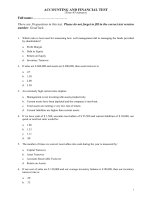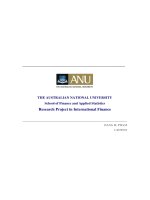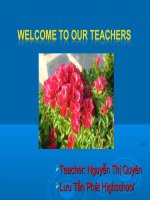Drawing and texturising
Bạn đang xem bản rút gọn của tài liệu. Xem và tải ngay bản đầy đủ của tài liệu tại đây (2.22 MB, 43 trang )
DRAWING &
TEXTURISING
Prepared By : Mazadul Hasan sheshir
ID: 2010000400008
13th Batch (session 2009-2013)
Department : Wet Processing Technology
Email:
Blog : www. Textilelab.blogspot.com (visit)
Southeast University
Department Of Textile Engineering
I/A 251,252 Tejgaon Dhaka Bangladesh
Prepared By :
Total Textile Process at a Glance
CONTENTS:
8/11/15
DRAWING & TEXTURISING
4
Introduction
What is Drawing?
Purpose of Drawing.
Principle of Drawing.
Drawing process.
Errors in Drawing.
Texturising.
Drawing.
What is texturising?
Drawing machine.
Purpose of texturising.
Steps of texturising
Texturising methods.
Conclusion.
8/11/15DRAWING & TEXTURISING5
Introduction
With the exception of silk ,all filaments are manufactured from
man-made materials. These materials, however don’t occur in
fibrous in nature. They are primarily made from chemicals that
must be formed and solidified into fiber form. Synthetic fibers
have been developed that posses describable characteristics, such
ass a high softening point to allow for ironing, high tensile
strength , adequate stiffness, and describable yarn quality. In their
origional state, the fiber–forming polymers are normally solids
and therefore must be first converted into a liquid form to be
suitable for extrusion. After extrusion there are some operation is
done for complete this process and to produce a good quality of
yarn. From these we will discuss about Drawing ant Texturising.
-Drawing is very important process of spinning.
-This process is used to increase the orientation of
polymer molecules.
-It produces filament with desired strength.
Fig. Two Stage Drawing Process
DRAWING
-Drawing process increases tensile
strength and hardness of filament.
-It orients the polymer molecules along
the filament.
-Crystallinity increases due to the
orientation of polymer molecules.
Crystalline and Strength
Fig: Change in orientation of polymer molecules
High degree of orientation of polymer
molecules
that tends to increase fibre stiffness.
Lower moisture absorption.
Unlimited breaking strength.
Transparency and luster.
Changed dyeing properties.
Resistance to penetration by foreign
molecules.
Properties Introduces by Drawing
What is Drawing?
8/11/15DRAWING & TEXTURISING9
Historically , the term Drawing was used in connection with the draw
frame in staple spinning. Drafting was used regarding roller drafting
system in roving and ring spinning .Polymeric fibre drawing is an
important industrial process. The objective behind drawing fibres is to
induce molecular orientation in the fibre, thereby increasing their
strength in the direction of the stretch. That is, Extension of the filaments
to many times their original length. By means of this operation, the more
or less randomly oriented chain molecules are aligned in the longitudinal
direction and the filaments its defirutive stress-strain characteristics.
Purpose of Drawing:
8/11/15DRAWING & TEXTURISING10
The prime purpose of drawing of a yarn is to a desirable quality for the
following reasons:
The orientation of the polymer molecules can be increased after the
spinning process by a subsequent drawing process.
To convert relatively week spun fibres to fibres with greater
molecular orientation and the resulting greater strength.
To produce a filament with a desired strength, accomplished by
inducing sufficient orientation of the polymer molecules along the axial
direction of the filament.
To produce fibres with the specific properties desired.
To increase the crystalline zone in fibres.
Principle of drawing:
8/11/15DRAWING & TEXTURISING11
Consider a sample of the input material before and after discontinuous
drawing. If there were no losses in the process, the mass of the input
sample would be the same as it is after drawing. Let p be the packing
density, a the cross sectional area , l the sample length, piaili be the mass
in the input sample, and poaolo be the mass after drawing. It follows that;
piaili ≈ poaolo
And if the packing density is constant
pili ≈ polo
For the purely theoretical case, the change in cross sectional area is
inversely proportional to the change in length. This is discontinuous
drawing. However ,in production. The process of elongation takes place
continuously wit the input and output mass flows nominally constant.
Thus , the formula can be restated to say that the cross sectional area is
inversely proportional to the speed ratio. In practice this is modified by
changes in the packing density and small losses have to be taken into
account , but it forms the basis of all drawing.
Drawing process:
8/11/15DRAWING & TEXTURISING12
The drawing process of a fibre involves passing the fibre tow over a
series of rollers. The rollers rotate at specified constant angular velocities,
each faster than the older. In some processes all the draw is introduced in
one step, in a single stage of feed and take-up rollers. This single draw
can result in fibre breakage so it is customary to involve more than one
more draw processes in the industries.
Molecular orientation during drawing
A typical two-stage drawing process:
8/11/15DRAWING & TEXTURISING13
Bechtel at. Al gave a model for a two-stage draw process in which most of
the draw was provided in the first stage( between 2.2 and 2.7 draw ratio)
and a relatively smaller draw (1.1-1.2) in the second stage. As the number
of stages is increased, it is possible to keep each free span and roller at a
different temperature and induce the maximum molecular orientation in
the fibre.
Drawing machine:
8/11/15DRAWING & TEXTURISING14
Place of Origin: Shandong China (Mainland)
Brand Name: TONGDA
Model Number: FA-316A
Type: Spinning Production Line
Spinning Method: Ring Spinning
Automatic: Yes
Condition: New
Textile machine: draw frame
Draw frame: high speed draw frame
Delivery number: 2 holes
Maxmium output speed: 600m/min
Total drafting mutiple: 5-14
times
Drafting style: 5 over 4 with pressure bar
Feeding sliver number: 6-8
pcs
Mainframe OAD: 2790*950*1645mm
Weight: 2200kg
Motor power: 4.0kw
Impact of drawing
8/11/15DRAWING & TEXTURISING15
The degree of alignment of fibre molecules affects the properties of a
fibre in several way;
Fibres change in appearance as they are drawn. In the undrawn
stage , nylon is usually dull and opaque. As the filaments are drawn
and molecule orientation increase, the filaments acquire the
transparency and luster.
The more closely the molecules pack together, the greater is the
ultimate strength, or breaking strength, of the fibre.
This increase in ultimate strength is accompanied by a decrease in
the amount of elongation that the fibre can sustain before reaching its
breaking point.
Because the closely packed molecules no longer have great
freedom of movement , a high degree of orientation also tend to
increase fibre stiffness and rigidity.
Increased resistance to penetration by foreign molecules also
improves the general chemical stability of a fibre, since highly
oriented fibres are more resistant to chemical attack.
Errors in drawing
8/11/15DRAWING & TEXTURISING16
Where there is a number of drafting stages, the results are
cumulative and the range of error wavelengths can be very large.
Yarns show not only an extremely large range of errors translate
into faults in the fabric. The end result of these irregularities is that
the fabrics made from the yarns show undesirable patterning known
as moiré or barrě , which reduces their values.
What is Texturising?
Texturing is a procedure used to increase the volume and the elasticity of a
filament fibres. The essential properties of textured yarns and the products
made from them are softness, fullness, a high degree of elasticity, thermal
insulation and moist transporting properties. All yarns which can be shaped
by heat are suitable for texturing. The prime purpose of texturing filament
yarn is to create a bulky structure.
8/11/15DRAWING & TEXTURISING17
The process of introducing crimp, loop, coils to
continuous filament yarn is called Texturizing. It
stabilizes the POY through heating and drawing.
Two types of manmade POY can be textured-
Nylon (Used in manufacturing of ladies
hosiery)
Polyester (Used in apparel & home furnishing)
TEXTURIZING
Some Texturizing Process
- Introduce mechanically by passing the filament
between gear like rollers.
- Produced chemically by controlling coagulation of a
filament in order to create asymmetric cross-section
in the fibre.
-The twist geometry is set by cooling the yarn
in a
highly twisted state.
-This process is applied with drawing process.
-False-twist is applied for Nylon and Polyester.
False-twisting
Crimping
- Introduced crimp are like as the shape of knitted loop
- Yarn is knitted into tubular fabric
- Then unraveled to produced textured yarn
-This method is used with a single type of yarn or with
a blend of filament yarns
-It is carried out by feeding a wet yarn or a dry yarn
Plus a small amount of water into a high-speed jet of
air.
-Yarns textured in such a process contain a large
number of very fine filaments
Air jet
Knit-deknitting
The prime purpose of texturing filament yarn is to create a bulky
structure that is desirable for the following reason;
The voids in the structure cause the material to have good
insulation properties.
The voids in the structure change the density of the
material(Which makes possible a lightweight yarn with good
covering properties)
The disorganized (or less organized) surface of the yarn gives
dispersed light reflections, which, in turn, give a desirable matte
appearance.
The sponge like structure feels softer than a lean twisted flat yarn.
The crimped or coiled filament structure gives a lower effective
modulus of elasticity to the structure when compare with that of a
flat yarn.
8/11/15DRAWING & TEXTURISING23
Steps of texturising:
8/11/15DRAWING & TEXTURISING24
Deform the filament.
Set the deformation.
Remove the deformation.
Texturising method:
8/11/15DRAWING & TEXTURISING25
Real twist Texturising
False twist Texturising
Draw Texturising
Knit de knit
Air jet Texturising
Stuffer box
Gear crimping
Edge crimping method
Texturising by co-extrusion









